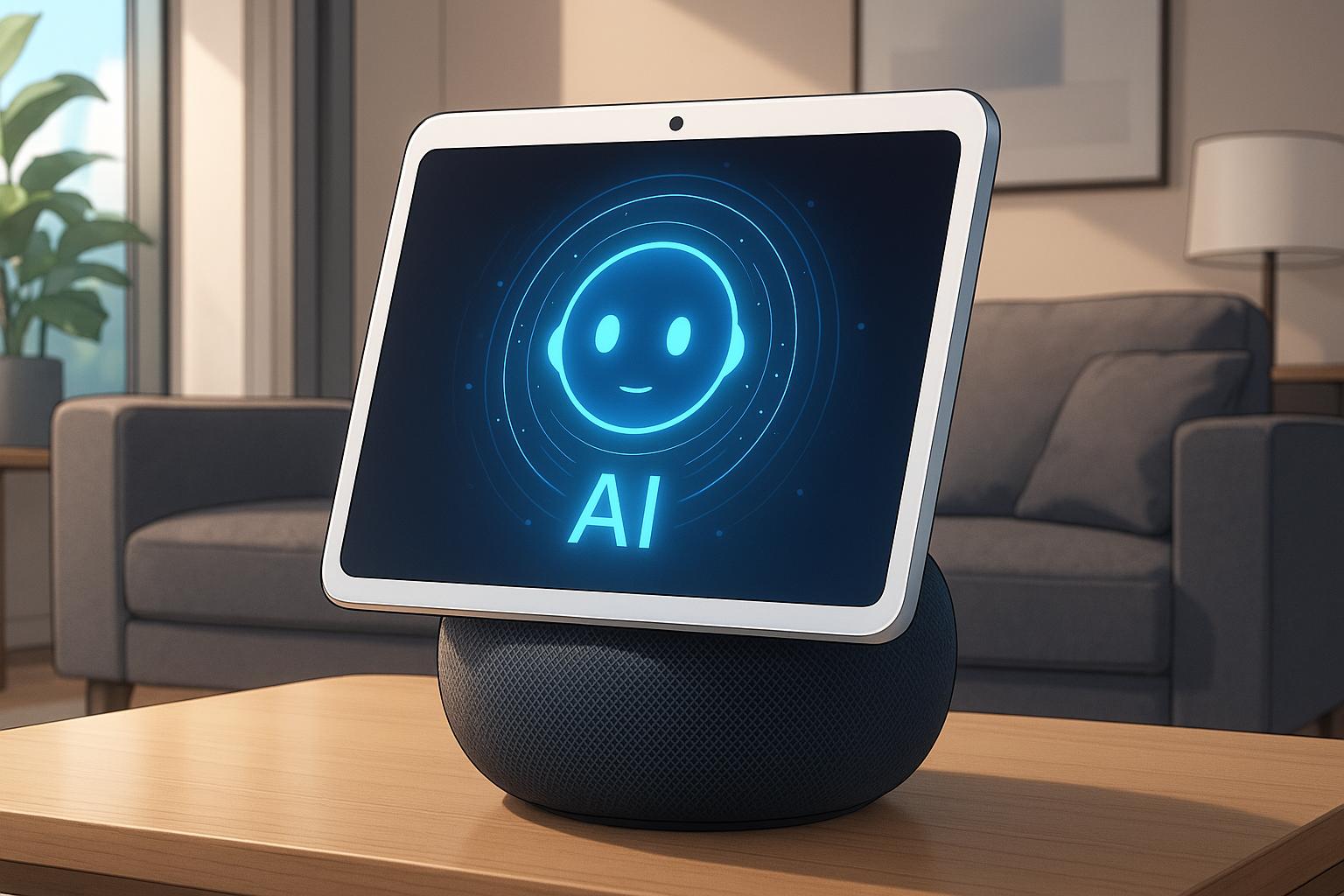Apple plans to launch its first AI-driven smart home control hub, rumoured as ‘HomePad’ and running a new homeOS, by early 2025. The device is set to modernise the company’s smart home offering with advanced AI features and integration, challenging rivals like Amazon and Google amid delays and engineering hurdles.
Apple is poised to make a significant entry into the smart home market with the anticipated launch of its first AI-powered home control hub, likely by the end of this year or early next. This device is rumoured to combine the aesthetics of a HomePod and an iPad, featuring a display which could measure around six or seven inches with thick bezels and a front-facing camera for video calls. As the company seeks to innovate in the smart home sector, it is crucial to understand how this device will integrate within Apple’s broader strategy, particularly as it relates to artificial intelligence.
The home hub, which may be branded as ‘HomePad’ or potentially run a new operating system called ‘homeOS,’ reflects Apple’s response to the growing demand for smart home solutions. The operating system is expected to be based on tvOS and will prominently feature Siri as well as Apple Intelligence, a newly developed AI platform. In recent years, Apple has faced criticism for lagging in the smart home arena compared to competitors and for delays concerning its AI features. According to Bloomberg’s Mark Gurman, the introduction of this home hub is part of Apple’s broader strategy to enhance its appeal in the AI space, which has seen substantial growth. Given that the company’s traditional revenue streams, particularly from iPhone sales, are experiencing deceleration, the new device could represent a pivotal shift.
Central to the functionality of this hub will be its ability to control an array of smart home devices through Apple’s existing HomeKit ecosystem, while also integrating features reminiscent of the iPhone’s StandBy dashboard. As the device is expected to support third-party apps, it aims not merely to be a control center but a comprehensive command hub for everyday smart home needs. Analysts suggest that the success of this initiative will hinge on the practical utility of its AI features and their ability to generate new service revenues.
While initial reports suggested a timeline aligned with the iPhone 17’s launch in September, technical challenges, especially regarding the development of Siri’s new capabilities, have led to speculation about possible delays, with a revised rollout potentially extending into 2026. As of now, the device could also boast features such as video calling through FaceTime, alerts from interconnected cameras, and a variety of widgets providing real-time information about weather, appointments, and more. Apple hopes that this layered functionality will help it compete fiercely against established players like Amazon and Google within this burgeoning market.
In addition to this initial offering, a more advanced device featuring a robotic arm is reportedly in the pipeline, although it is not expected to reach the market until at least a year or two after the home hub’s launch. The anticipation surrounding these innovations illustrates Apple’s aspirations to not only strengthen its footprint in the smart home sector but also its commitment to harnessing AI to transform how consumers interact with technology on a daily basis.
As Apple prepares for this potentially game-changing launch, the clarity and effectiveness of the home hub’s AI functionalities will be crucial in determining its success. The enhanced focus on generative AI promises to elevate the user experience, but the execution of these features remains a pressing concern for the tech giant. With substantial engineering challenges still ahead, only time will tell whether Apple’s smart home hub will live up to the considerable expectations that surround it.
Reference Map:
- Paragraph 1 – [1], [2]
- Paragraph 2 – [3], [5], [6]
- Paragraph 3 – [2], [4], [6]
- Paragraph 4 – [1], [3], [4]
- Paragraph 5 – [6], [1], [7]
Source: Noah Wire Services
- https://www.techradar.com/home/smart-home/apples-ai-smart-home-hub-could-launch-this-year-here-are-4-things-to-expect – Please view link – unable to able to access data
- https://www.ft.com/content/ad1ea5a3-15db-4d72-916a-c4587c651493 – Apple is preparing to make a significant move into the smart home market by introducing an AI-powered home control hub. The device is expected to feature a six-inch wall-mounted screen, with plans to launch in 2025. This initiative marks Apple’s most substantial entry into the smart home sector since the introduction of HomeKit a decade ago. The company aims to leverage generative AI to enhance device responsiveness and utility, with a focus on integrating App Intents to allow Siri to autonomously perform app functions. The success of this venture will depend on the practical usefulness of the AI features and their ability to generate new service revenues, especially as Apple’s traditional product lines, like the iPhone, experience slower growth.
- https://www.macrumors.com/2024/11/12/apple-home-command-center-march-2025/ – Apple is reportedly planning to launch an AI-powered smart home display, referred to as a ‘command center,’ as early as March 2025. The device is expected to feature a six-inch square display with thick bezels, a front-facing camera for FaceTime, internal speakers, and a built-in rechargeable battery. It will run a new operating system, potentially named ‘homeOS,’ based on tvOS, and will prominently feature Siri and Apple Intelligence. The device aims to serve as a central hub for controlling smart home products and accessing apps, with a customizable home screen displaying widgets for weather, appointments, photos, and home controls. It will also support video calling and provide alerts and camera footage from connected smart home cameras.
- https://www.macrumors.com/2025/03/09/apple-smart-home-hub-postponed/ – Apple has reportedly postponed the launch of its anticipated smart home hub due to delays in Siri’s development. Initially expected to be announced in March 2025, the device’s release has been pushed back as it relies on the delayed Siri capabilities. The smart home hub is expected to feature a six-inch or seven-inch display, an A18 chip, and Apple Intelligence support. It is designed to control smart home appliances, conduct FaceTime chats, and handle other tasks. The device can be attached to a tabletop base with a speaker or mounted on a wall. The new launch timeline remains uncertain, with the device now expected to launch in the coming year.
- https://www.macrumors.com/2025/04/07/apple-might-delay-smart-home-hub/ – Apple is considering delaying the launch of its new smart home hub until 2026 due to major engineering challenges with the revamped Siri voice assistant that powers the device. Initially, the product was expected to be released around the time of this year’s iPhone 17 series launch in September. However, these challenges have led to a potential postponement. The smart home hub is expected to feature a seven-inch square display, Apple Intelligence, and a new operating system that would integrate with Apple’s ecosystem. The device aims to compete with similar products from Amazon and Google in the smart home market.
- https://www.macworld.com/article/2562280/apples-home-strategy-for-2025-and-what-it-means-for-the-homepod.html – Apple is planning to significantly expand its smart home strategy in 2025 by introducing a new operating system, potentially named ‘homeOS,’ to unify its smart home devices. This move aims to simplify the user experience and enhance device integration. The company is also focusing on deeper device integration and improved software to strengthen its ecosystem and remain competitive in the smart home market. The introduction of homeOS is expected to bring together various hardware lines and provide a standardized smart home platform, benefiting devices like the HomePod and HomePod mini. However, questions remain about what unique features the new smart display will offer compared to existing devices like the iPad.
- https://en.wikipedia.org/wiki/Apple_Intelligence – Apple Intelligence is an artificial intelligence system developed by Apple Inc., announced on June 10, 2024, at WWDC 2024. It is integrated into Apple’s iOS 18, iPadOS 18, and macOS Sequoia operating systems. Apple Intelligence relies on a combination of on-device and server processing to provide AI capabilities across Apple’s devices. It was initially launched for developers and testers on July 29, 2024, in U.S. English, with full support for additional English dialects, including UK English, added on December 11, 2024. The system aims to enhance user experience by offering contextualized commands and seamless integration across Apple’s ecosystem.
Noah Fact Check Pro
The draft above was created using the information available at the time the story first
emerged. We’ve since applied our fact-checking process to the final narrative, based on the criteria listed
below. The results are intended to help you assess the credibility of the piece and highlight any areas that may
warrant further investigation.
Freshness check
Score:
7
Notes:
The narrative presents recent developments regarding Apple’s AI smart home hub, with references to reports from May 2025. However, similar information has been reported since November 2024, indicating that the core content is not entirely fresh. The inclusion of updated data about potential delays and features may justify a higher freshness score but should still be flagged. ([macrumors.com](https://www.macrumors.com/2024/11/12/apple-home-command-center-march-2025/?utm_source=openai), [macrumors.com](https://www.macrumors.com/2025/04/07/apple-might-delay-smart-home-hub/?utm_source=openai))
Quotes check
Score:
8
Notes:
The narrative includes direct quotes from Bloomberg’s Mark Gurman, such as:
> “At one point, the company had hoped to announce this product in March.”
These quotes are consistent with earlier reports from March 2025, suggesting that the content is not entirely original. ([macrumors.com](https://www.macrumors.com/2025/03/09/apple-smart-home-hub-postponed/?utm_source=openai))
Source reliability
Score:
9
Notes:
The narrative originates from TechRadar, a reputable technology news outlet, which strengthens its credibility.
Plausability check
Score:
8
Notes:
The claims about Apple’s AI smart home hub align with previous reports from sources like MacRumors and the Financial Times, indicating consistency and plausibility. ([macrumors.com](https://www.macrumors.com/2024/11/12/apple-home-command-center-march-2025/?utm_source=openai), [ft.com](https://www.ft.com/content/ad1ea5a3-15db-4d72-916a-c4587c651493?utm_source=openai))
Overall assessment
Verdict (FAIL, OPEN, PASS): OPEN
Confidence (LOW, MEDIUM, HIGH): MEDIUM
Summary:
The narrative provides a comprehensive overview of Apple’s AI smart home hub, incorporating recent updates and quotes from reputable sources. However, the core content has been reported since November 2024, and the inclusion of earlier quotes suggests some recycled material. While the source is reliable and the claims are plausible, the lack of entirely fresh content and potential reuse of earlier material warrant further scrutiny.













